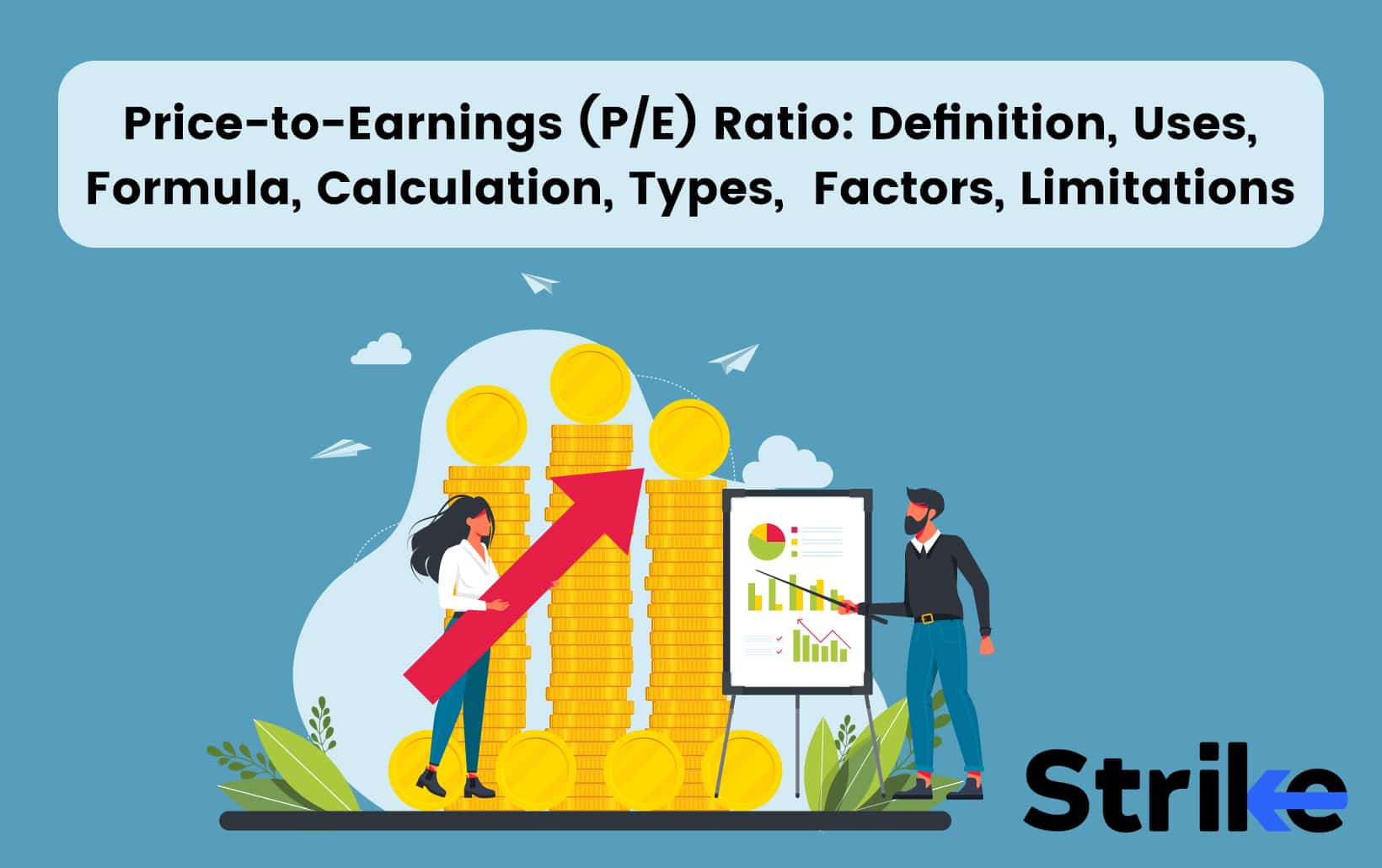
The Price-to-Earnings (P/E) ratio is one of the most widely used metrics for investors to evaluate companies and make informed investment decisions. The P/E ratio provides a simple yet effective way to compare stock valuations by relating a company’s stock price to its earnings. The P/E ratio indicates how much an investor is willing to pay for each rupee of a company’s earnings.
It helps identify undervalued stocks trading at attractive prices relative to their earnings potential, as well as avoid overpaying for overvalued stocks. The P/E ratio should be analyzed in the context of a company’s financials, growth prospects, industry peers, and broader market valuations. A company’s historical P/E can provide insights into periods of undervaluation or overvaluation.
Different variations of the P/E ratio, like trailing, forward and relative P/Es, are used depending on the analysis required. Multiple factors influence P/E levels across sectors and market cycles. This article seeks to provide a comprehensive overview of the Price-to-Earnings ratio – how it is calculated, the different types of P/E ratios used, interpreting what high and low P/Es signify, limitations to be aware of as well as how to effectively analyze stocks using this important valuation metric.
What is the Price-to-Earnings (P/E) ratio?
The Price-to-Earnings ratio (P/E ratio) is an important metric used by investors to determine the valuation of a company’s stock. The P/E ratio compares the current market price of a company’s shares to the company’s earnings per share. It provides a measure of how much investors are willing to pay for each rupee of the company’s earnings.
A high P/E ratio generally indicates that investors expect higher growth from the company in the future compared to companies with a lower P/E. It suggests investors are willing to pay more for the stock today relative to current earnings, betting that the company’s earnings will increase substantially in the future. Conversely, a low P/E suggests that investors believe the company is either overvalued or expects limited growth potential compared to other companies in the same industry or the broader market. To calculate the P/E ratio, you simply divide the current stock price by the earnings per share. The resulting ratio provides a standardized way for investors to compare the valuation and expected growth prospects between different companies. The P/E is one of the most widely used metrics in stock analysis and valuation.
What are the uses of the P/E ratio?
The P/E ratio is used by investors to gauge a stock’s valuation and growth prospects compared to earnings, screen for potentially undervalued opportunities, assess sentiment and earnings quality and provide context for fundamental analysis when making investment decisions in the stock market.
- Gauge valuation: The P/E ratio helps investors determine whether a stock is undervalued or overvalued compared to its earnings. Stocks with low P/Es are sometimes undervalued, while high P/Es could signal overvaluation. Comparing P/Es across similar companies or sectors gives context for valuation.
- Assess growth prospects: High P/E ratios tend to indicate that investors expect strong growth from the company. The market is willing to pay more for future earnings potential. However, high P/Es also raise the risk of unmet expectations. Low P/Es suggest limited expected growth.
- Screen for value stocks: Investors use low P/E ratios to screen for potentially undervalued stocks. Comparing a stock’s P/E to its historical average or industry peers is able to uncover discounted opportunities. Value investors favour stocks with low P/Es.
- Gauge market sentiment: The overall market P/E provides insight into investor sentiment and market valuations. High market P/Es imply bullishness and confidence in growth, while low P/Es suggest a bearish, risk-off sentiment. Comparing the current market P/E to historical averages provides perspective.
The P/E should be assessed alongside profit margins, debt levels and other factors to judge earnings quality. High P/Es with poor-quality earnings sometimes signal overvaluation and vice versa. The context around earnings is key.
What is the formula of the P/E ratio?
The formula to calculate the P/E ratio is the company’s current stock price divided by its earnings per share or EPS.
P/E Ratio = Current Share Price / Earnings per Share
The P/E ratio is a dynamic ratio and keeps changing with the company’s performance and market sentiments. The ‘P’ or market price in the ratio fluctuates daily while the ‘E’ or earnings per share changes quarterly as earnings are announced. Therefore, an investor should check the P/E ratio regularly to identify any major deviations from the company’s normal valuation range.
When comparing P/E ratios within a sector, lower ratios indicate cheaper valuations, whereas higher ratios signal expensive valuations. However, P/E ratios cannot be compared across different sectors as each sector has a different normal P/E range. For example, technology stocks tend to have higher P/E ratios because of their higher growth rates, whereas utilities and financial sector stocks usually have lower P/E ratios.
How to calculate the P/E ratio of a stock?
Calculating the price-to-earnings (P/E) ratio of a stock requires getting the current market price per share and the company’s earnings per share (EPS) in rupees. Let’s walk through an example using a fictional company.
First, we need the current stock price. We’ll say the shares are trading at ₹500 on the Indian stock exchanges.
Next, we determine the EPS over the trailing 12 months. Let’s assume the company had a net income of ₹100 crores last year and has 10 crore shares outstanding. To get EPS, we take the ₹100 crore profit and divide it by the 10 crore shares, which gives us ₹10 EPS.
Now that we have the market price per share (₹500) and the EPS (₹10), we are able to calculate the P/E ratio using the formula as stated below.
P/E Ratio = Market Price per Share / Earnings per Share
Plugging in the numbers as stated below.
P/E Ratio = ₹500 per share / ₹10 EPS
This gives us a P/E ratio of 50 for this fictional Indian company.
What is meant by a high P/E ratio?
A high P/E ratio generally means that the investors expect high earnings growth in the future compared to companies with a lower P/E. Typically, growth stocks have high P/E ratios, while value stocks have lower P/E ratios. There are five key reasons why a company sometimes has a high P/E ratio in the stock market growth expectations: competitive advantages, business model potential, hype and speculation and industry trends.
One reason for a high P/E ratio is that investors have optimism about the company’s future growth potential. Investors are willing to pay more for shares today because they believe earnings will grow substantially over time. High expected revenue and profit growth justify higher valuations. Companies like technology and biotech stocks often have high P/E ratios due to their potential for expansion.
What is meant by a low P/E ratio?
A low P/E ratio typically signals that a stock sometimes is undervalued by the market. A low P/E ratio often reflects that the market expects relatively slow or stagnant growth from the company in the future. Investors will not be willing to pay a high earnings multiple if earnings are expected to remain flat or grow minimally over time. Typically, mature, established companies in slow-changing industries carry lower P/E ratios that reflect their limited growth opportunities. Companies in highly cyclical industries like manufacturing, commodities, and financials also tend to have lower P/E ratios.
Their earnings fluctuate significantly over economic cycles, falling during recessions and peaking during expansions. Investors apply lower multiples due to the volatility and unpredictability of their earnings. Companies facing competitive threats or disruption also sport lower P/E ratios. Investors sometimes are concerned about declining market share, shrinking margins, or other challenges to profitability that constrain earnings growth. Oftentimes, so-called “value traps” appear cheap based on P/E but suffer from structural industry issues.
What does a negative P/E ratio mean?
The most common reason for negative EPS is that the company had operating losses for the year. This means total costs and expenses exceed total revenues, resulting in a net loss on the income statement. All else being equal, a net loss will translate into a negative EPS. Startups and young companies often operate at losses as they invest heavily to grow the business before achieving profitability. Sometimes, EPS turns negative due to large non-cash charges like depreciation, amortization, and impairment costs.
These accounting expenses decrease reported earnings even though they do not represent an outflow of cash. Technology companies, for example, often have high non-cash depreciation costs related to equipment and facilities. Investors should focus on cash earnings to strip out these non-cash impacts on EPS. Extraordinary one-time events sometimes also wipe out EPS and lead to a single year of negative earnings. Events like lawsuit settlements, restructuring charges, inventory write-downs, and asset impairments sometimes depress earnings temporarily. The core operations are sometimes still profitable, but these one-off hits create a single period of negative EPS.
What is a good P/E ratio?
Each sector has a different normal P/E range. High-growth industries like technology tend to have higher P/E ratios, around 20-30x, while slower-growing industries like financials and industrials average mid-teens P/E ratios. Comparing a stock’s P/E to its peer group provides a better gauge of relative value. A tech stock with a P/E of 25x is not necessarily overpriced if competitors all have similar P/Es. Higher P/E ratios are often justified for companies expected to deliver above-average earnings growth.
A company with a P/E of 40x but forecasted to grow earnings at 40% per year is sometimes reasonably valued. Investors validate higher multiples for higher growth outlooks. Slow-growing companies command lower industry typical P/Es, such as 10-12x. Looking at a stock’s historical P/E range over a 5-10-year period provides a helpful perspective. A P/E well above the normal range likely signals overvaluation, while a P/E below historical norms means possible undervaluation. Sudden surges in valuation often revert back toward the average eventually.
Where can you find the P/E ratio of a stock?
Strike is the best tool to use when looking up the P/E ratio of a stock. Strike provides real-time data on key metrics like the price-to-earnings ratio for any publicly traded company. With Strike, you will be able to quickly look up the latest P/E ratio for any stock just by searching for the ticker symbol.
How do we compare the P/E ratio of the two companies?
To evaluate which company’s stock is more attractively valued, investors compare the current price-to-earnings ratios of Company A and Company B, with the lower P/E potentially indicating a cheaper valuation relative to earnings.
Reliance Industries Limited (RIL) and Tata Consultancy Services Limited (TCS) are two of the largest and most valuable companies in India. RIL is a diversified conglomerate involved in energy, petrochemicals, retail, telecom and other sectors. TCS is India’s largest IT services and consulting company. RIL has a trailing 12-month P/E ratio of 16.8 based on its latest quarterly results. TCS has a trailing P/E of 24.6. TCS is trading at a 45% premium to RIL in terms of P/E. This indicates that the market expects TCS to deliver stronger earnings growth compared to RIL.
TCS trades at a 45% premium to RIL in terms of P/E ratio due to its faster revenue growth, higher profit margins, stronger earnings outlook, attractive dividends, robust balance sheet, and stability of the business model. Specifically, TCS has delivered a 15% revenue CAGR over the past 3 years compared to just 2% for RIL, driven by rapid growth in the IT services industry from digital transformation versus maturation of RIL’s energy and petchem businesses. Additionally, TCS enjoys operating margins of 25% versus 11% for RIL due to the high-margin nature of IT services versus the competitive dynamics in RIL’s retail and telecom segments.
TCS also has stronger 18-20% expected earnings growth versus 10-12% for RIL. Further, TCS offers stable 2.5% dividend yields, while RIL’s payouts have been inconsistent. Moreover, TCS has a debt-free balance sheet compared to RIL’s leveraged position. Finally, TCS enjoys stable, recurring revenue streams, unlike RIL’s profits, which are vulnerable to oil prices and industry cyclicality. The higher P/E ratio suggests that investors find TCS’s growth prospects, profitability, dividend payouts, and balance sheet more attractive. The market believes TCS deserves a premium valuation compared to RIL.
However, the gap in valuations also indicates that expectations from TCS are very high. Any disappointment in earnings or guidance sometimes leads to a sharp correction in the stock price and P/E contraction. RIL has more room for upside if it delivers on its growth projects.
What are the different types of P/E ratios?
The main types of P/E ratios are standard/trailing P/E, forward P/E, absolute P/E, relative P/E, and justified P/E. Investors analyze these five P/E ratios to determine if a stock is undervalued or overvalued compared to historical norms and sector averages.
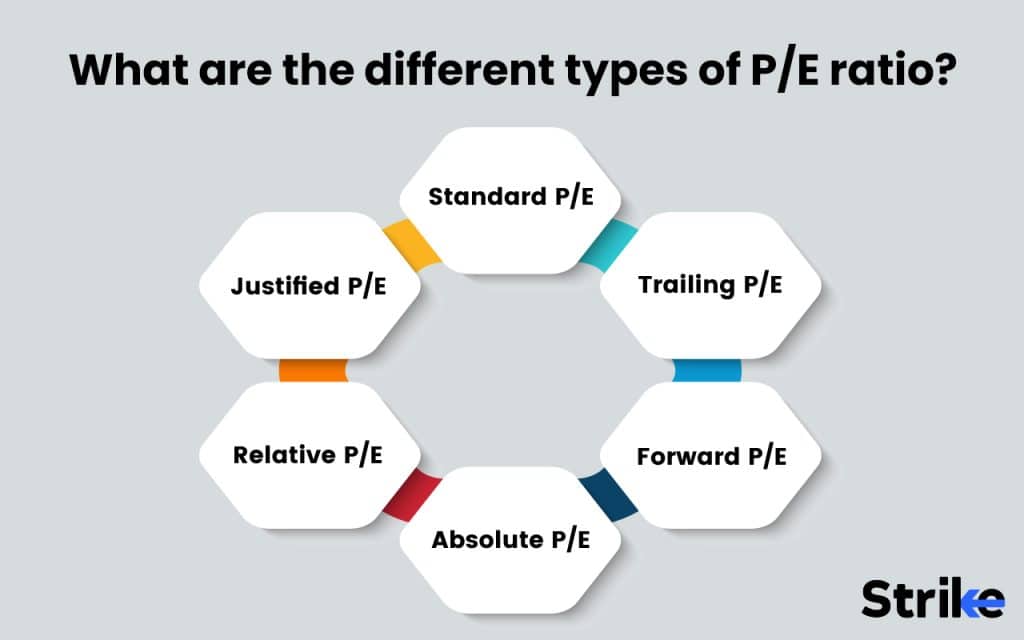
1.Standard P/E
The price-to-earnings ratio (P/E ratio) is a valuation metric used by investors to compare a company’s current share price to its per-share earnings. The P/E ratio gives investors an idea of how much they are paying for each rupee of a company’s earnings.
To calculate the standard P/E ratio, you take the current market price per share of a company’s stock and divide it by the company’s earnings per share over the past 12 months. For example, if a company’s stock is trading at ₹3000 per share, and the company reported ₹120 in earnings per share over the trailing 12 months, the P/E ratio would be ₹3000 / ₹120 = 25. This means investors are currently paying ₹25 for every ₹1 of earnings per share generated by the company over the last year.
2. Trailing P/E
The trailing price-to-earnings (P/E) ratio is a variation of the standard P/E ratio. It is calculated by taking the current market price per share of a company’s stock and dividing it by the company’s earnings per share over the past 12 months or trailing 12 months (TTM).
For example, if a company’s stock is trading at ₹3000 per share, and the company reported earnings of ₹120 per share over the last 12 months, the trailing P/E ratio would be ₹3000 / ₹120 = 25. This tells investors they are currently paying ₹25 for every ₹1 of earnings the company generated over the past year. The trailing P/E ratio uses the company’s actual earnings from the immediate past four quarters. This gives investors an idea of the stock’s valuation based on recent historical performance.
3. Forward P/E
The forward price-to-earnings (P/E) ratio is a variation of the standard P/E ratio. It is calculated by taking the current market price per share of a company’s stock and dividing it by the estimated future earnings per share over the next 12 months.
For example, if a company’s stock is trading at ₹3000 per share and analysts estimate earnings will be ₹150 per share over the next year, the forward P/E ratio would be ₹3000 / ₹150 = 20. This tells investors they are currently paying ₹20 for every ₹1 of estimated future earnings per share. The forward P/E ratio uses projected earnings rather than historical earnings like the trailing P/E. This gives investors an idea of the stock’s valuation relative to expected future performance.
4. Absolute P/E
The absolute price-to-earnings (P/E) ratio differs from the standard P/E ratio in that it looks at a company’s valuation in isolation rather than comparing it to peers or the broader market.
It is calculated by simply taking the current share price and dividing it by the company’s earnings per share. For example, if a stock is trading at ₹3000 per share, and the company reported earnings of ₹120 per share, the absolute P/E would be ₹3000 / ₹120 = 25. The absolute P/E ratio provides a historical benchmark to compare valuation over time for a single company. It means investors are willing to pay more per rupee of earnings than in the past if the absolute P/E is rising.
5. Relative P/E
The relative price-to-earnings (P/E) ratio compares a company’s P/E ratio to a benchmark or market index P/E ratio. It provides context on valuation by looking at the stock’s P/E ratio versus the broader market.
It is calculated by taking the stock’s P/E ratio and dividing it by the P/E ratio of a market index or benchmark. For example, if a stock has a P/E of 20 and the market index P/E is 15, the relative P/E would be 20 / 15 = 1.33. It means the stock’s P/E is higher than the market if the relative P/E is greater than 1, suggesting potential overvaluation. A relative P/E below 1 indicates the stock is sometimes undervalued compared to the broader market.
6. Justified P/E
The justified price-to-earnings (P/E) ratio differs from standard P/E ratios as it aims to calculate what the P/E multiple should be based on expected future performance.
It is calculated by taking the company’s forecasted earnings per share for the next 12 months and dividing it by the required rate of return or cost of equity. For example, earnings are estimated at ₹150 per share, and investors expect a 15% return; the justified P/E would be ₹150 / 0.15 = 10. The justified P/E provides a benchmark to evaluate if the current market P/E ratio is reasonable based on fundamentals.
While the standard or trailing P/E looks at past earnings, forward P/E uses estimated future earnings. Absolute P/E compares a stock’s P/E to historical averages, while relative P/E compares it to industry peers. Justified P/E tries to determine an appropriate multiple based on projected growth rates.
What are the factors affecting the P/E ratio?
A company’s earnings and sales growth is a major determinant of its P/E ratio. Faster-growing companies tend to command higher P/E ratios while slower-growing companies have lower P/E ratios. Investors are willing to pay more for shares of high-growth companies as they expect higher future earnings potential. As a result, high-growth companies like technology and consumer stocks often trade at elevated P/Es compared to slower-growing companies. For example, a high-tech company growing earnings at 30% annually could justifiably trade at a P/E of 40-50x.
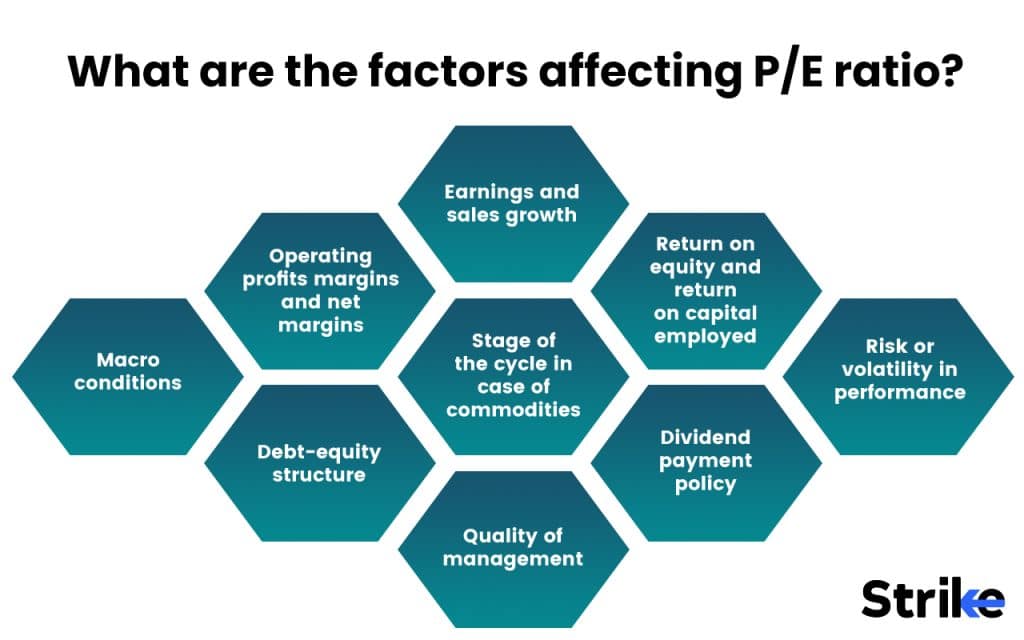
In comparison, a mature company in a slow-growth industry growing at just 5% would warrant a much lower P/E of 10-15x. The high growth prospects allow investors to rationalize paying a higher premium. A company’s profitability metrics, like operating profit margin and net profit margin, also impact its P/E ratio. Companies with expanding margins tend to command higher P/Es. Higher margins signal a company with strong competitive advantages and pricing power. Investors see higher margins providing greater earnings leverage going forward. For example, a consumer staples company with a 25% operating margin could warrant a P/E of 18-20x. Meanwhile, a luxury retailer with just a 10% operating margin would trade at a lower P/E of 12-15x. The higher margins provide more buffer during downturns.
A company’s return on equity (ROE) and return on capital employed (ROCE) also influence its P/E ratio. Companies with higher ROE and ROCE tend to have higher P/Es since they generate more profits from the capital invested in the business. Strong returns also signify competitive advantages in the industry. For example, an FMCG company with a ROE of 22% could trade at a P/E of 25-30x, while another FMCG firm with a ROE of just 15% would warrant a lower P/E of 18-22x. The higher returns allow higher reinvestment back into the business.
A company’s capital structure in terms of debt levels, along with its dividend payout, also sway P/E ratios. Highly leveraged companies trade at lower P/Es due to higher insolvency risks. Companies paying higher dividends relative to earnings command higher P/Es as investors value the income. For example, a high-debt company sometimes trades at 8-12x P/E, while a similar low-debt company trades at 12-16x. A mature company paying 50% of earnings as dividends could warrant 16-20x P/E versus just 10-14x for a non-dividend payer. Conservative capital structures and dividends provide reassurance.
A company’s dividend payout policy is able to influence its P/E ratio. Mature companies with steady earnings that pay out consistent, high dividend yields will often have lower P/E ratios, as investors treat the stocks akin to bonds where much of the return comes from the dividend. Speculative high-growth companies that retain earnings to reinvest in growth instead of dividends tend to have higher P/E ratios.
What are the limitations of the P/E ratio?
The P/E ratio has limitations as a valuation metric because it relies solely on current or estimated earnings, does not account for qualitative factors, differences in accounting practices or one-time events, and lacks usefulness for evaluating young or growth companies that reinvest profits. The P/E ratio is highly dependent on current earnings, which are able to fluctuate significantly. Earnings per share are able to be volatile from year to year depending on factors like economic conditions, consumer demand, production costs, lawsuits, and tax changes.
A temporary increase or decrease in earnings is able to make the P/E ratio look artificially high or low. As such, the P/E ratio does not always accurately reflect the company’s long-term earning power and growth potential. Investors should look at earnings averages over multiple years rather than current-year earnings alone when evaluating P/E ratios.The P/E ratio does not account for differences in accounting practices between companies. Accounting policies around areas like depreciation, inventory valuation, and R&D expenses sometimes affect earnings. Therefore, P/E ratios are, at times, not directly comparable across companies with different accounting practices. Investors must dig deeper into financial statements to adjust for these differences before comparing P/E ratios.
The P/E ratio also does not reflect balance sheet health, cash flows, dividends, buybacks and other important financial factors. It should not be used in isolation for stock valuation. The P/E ratio can be impacted by non-recurring events, which sometimes do not reflect real operating performance. Events like asset sales, inventory liquidations, tax law changes, and restructuring costs artificially impact earnings used in P/E ratios. Similarly, changes in capital structure, like issuing new debt or equity, are able to influence the P/E without changes to company fundamentals. Investors should normalize earnings by removing one-time events when using P/E ratios.
The appropriate P/E ratio varies significantly across industries. High-growth industries tend to have higher P/E ratios versus slow-growing or cyclical industries. Comparing P/E ratios across very different industries is sometimes not useful. Investors should compare P/E ratios among peers in the same industry group rather than broadly across the entire market. Even within an industry, target P/E ratios are able to vary based on growth projections, competitive advantages, risk profiles and other factors.
How do you analyze a stock using the P/E ratio?
Start P/E analysis by comparing the stock’s current P/E to its historical average P/E over a 5 to 10-year period. This provides perspective on whether the stock is trading above or below its normal valuation range. Also, compare the current P/E to the average P/E of the stock’s industry peers. This shows whether the stock is relatively undervalued or overvalued within its sector. Dig deeper to understand whether there are fundamental reasons like strong growth, competitive advantages or consolidation in the industry driving the valuation premium if the current P/E is significantly higher than historical norms.
Evaluate the earnings used in the P/E ratio to ensure there are no accounting anomalies or one-time events distorting the earnings figure. Earnings can be temporarily inflated or depressed by factors like asset sales, inventory adjustments, lawsuits, impairment charges, or tax changes. These non-recurring items should be normalized before using the earnings in the P/E analysis. Also, break down how much of the earnings growth is coming from margin expansion versus revenue growth to assess the quality of earnings. Higher margins could flag potential issues like underinvestment in R&D or customer squeeze.
Make sure you use forward P/E ratios based on future earnings estimates rather than just trailing P/E ratios. This provides a better picture of how attractive the current valuation is in relation to earnings growth expected over the next 12-24 months. Scrutinise analyst earnings estimates for reasonableness by looking at past forecast accuracy, scenarios for top-line growth rates and profitability trends. Conservative earnings forecasts are better for forward P/E analysis. Analyze the company’s competitive position and outlook to support its expected earnings growth.
Factors like market share gains, new products, network effects, switching costs and cost advantages are able to drive higher growth and justify higher P/E multiples. Weakening competitive position or disruption risks could warrant applying a lower P/E ratio. The strength of the underlying business model must align with the growth assumptions behind a higher P/E valuation. Assess what is driving the stock’s price performance – is it broad market sentiment or company-specific fundamentals? Stocks in a hot sector are able to get overvalued together due to overall investor enthusiasm. Similarly, an overall bearish sentiment sometimes depresses the P/E ratio across an industry temporarily. Separating sector and market sentiment from fundamentals provides context for whether the stock’s P/E is justified.
Evaluate the impact of prevailing interest rates on the attractiveness of the stock’s P/E. Lower risk-free rates increase the relative attractiveness of future earnings, allowing higher P/E ratios across equities markets. The multi-year bull market and lower interest rates have led to P/E expansion for the overall market. This should be accounted for when comparing current P/E to historical averages. Interest rate assumptions must align with growth expectations used in forward P/E forecasting.
What is the historical P/E ratio of the Indian stock market?
The Indian equities have oscillated between exuberant overvaluations and depressed undervaluations over the years, with the market P/E ratio ranging from a frothy 30s during the late 1990s technology boom to single digits during periods of economic strife and stagnation before recovering to more normalized valuations in the mid to high teens in recent years.n The P/E ratio of the Indian stock market has fluctuated between 12-37 times over the past few decades, depending on prevailing macroeconomic conditions, earnings growth and liquidity environment. In India, the two most tracked equity indices are the Nifty 50 and the Sensex. Their historical P/E ratios provide insights into how Indian equities have been valued over different market cycles.
In the early 1990s, the Indian economy underwent major reforms under the leadership of Prime Minister P.V. Narasimha Rao. This included liberalization, privatization and the opening up of various sectors. During this transformative phase, the P/E multiples of both Nifty and Sensex steadily expanded. As per a Crisil Research report, Nifty’s P/E ratio increased from 15.6 times in FY92 to 17.3 times in FY96. Reflecting the optimism around economic reforms, the re-rating pushed the Nifty to all-time high valuation levels by 1996. However, the ‘Asian Crisis’ of 1997 led to a sharp correction in Indian equities. By FY98, the Nifty P/E contracted to 12.9 times.
The dot-com boom in 1999-2000 provided a bit of a lift to Indian tech stocks. But the Nifty P/E stayed around 13-14 times as the broader economy continued to struggle. In the bull market between 2003 and 2008, corporate earnings growth accelerated, and the Nifty saw a re-rating to a peak P/E of 22.5 times in January 2008. However, the Global Financial Crisis in 2008 led to foreign capital outflows from India. Between 2008 and 2013, the Nifty traded in a broad range with muted earnings growth. Its P/E ratio averaged around 18-19 times during this period.
The election of a stable NDA government in 2014, coupled with reforms like GST, gave a boost to market sentiment. This pushed the Nifty P/E to an all-time high of 28.5 times in July 2015. However, concerns around corporate leverage and a slowdown in growth brought valuations down. The Nifty P/E declined to around 23 times by 2019. The Covid-19 pandemic resulted in a sharp correction and slide in earnings during the first half of 2020. But massive global liquidity infusion and quicker-than-expected demand recovery lifted the markets. The Nifty P/E hit a record high of 36.4 times in October 2021 before moderating to around 20 times now. The Sensex P/E ratio has also followed a similar trajectory as the Nifty.
From around 15 times in the early 1990s, it steadily expanded to above 25 times by the mid-1990s economic boom. After dropping to 12-13 times around 2000, the Sensex P/E saw a strong re-rating during the 2003-2008 bull market to 26 times. The Sensex P/E remained elevated at the early 20s level from 2008 to 2014. Buoyed by reforms and liquidity, it surged to an all-time high of 33 times in July 2015 before moderating to 29 times by early 2018. After dropping to around 23 times during the pandemic selloff, the Sensex P/E spiked to 37.5 times in October 2021 before cooling off recently.
Is the PEG ratio better than the P/E ratio?
Yes. The PEG ratio (price/earnings to growth ratio) is generally considered better than the P/E ratio for stocks with high expected earnings growth.
PEG stands for price/earnings-to-growth and is calculated by dividing the P/E ratio by the expected earnings growth rate. For example, a stock with a P/E ratio of 30 and expected earnings growth of 15% will have a PEG of 2 (30/15). The PEG adjusts the P/E ratio by factoring in the growth potential. By incorporating future growth estimates, PEG provides a more complete picture of valuation. A lower PEG ratio generally indicates that a stock is undervalued, given its growth prospects, while a higher ratio suggests potential overvaluation.
How do we determine valuation using the P/E ratio?
The P/E ratio, a critical component in stock valuation, is calculated by dividing a company’s share price by its earnings per share. This valuation metric helps investors assess whether a stock is priced fairly. A lower P/E ratio suggests that the stock is less expensive relative to its earnings, indicating a potentially undervalued situation. Conversely, a higher P/E ratio might signal an overvalued stock. Investors often compare a company’s P/E ratio with the average P/E ratio of its industry or sector. This comparison serves as a benchmark for valuation, helping to determine if a stock is undervalued or overvalued in the context of its peers. Thus, the P/E ratio is a vital tool for valuation in investment analysis.




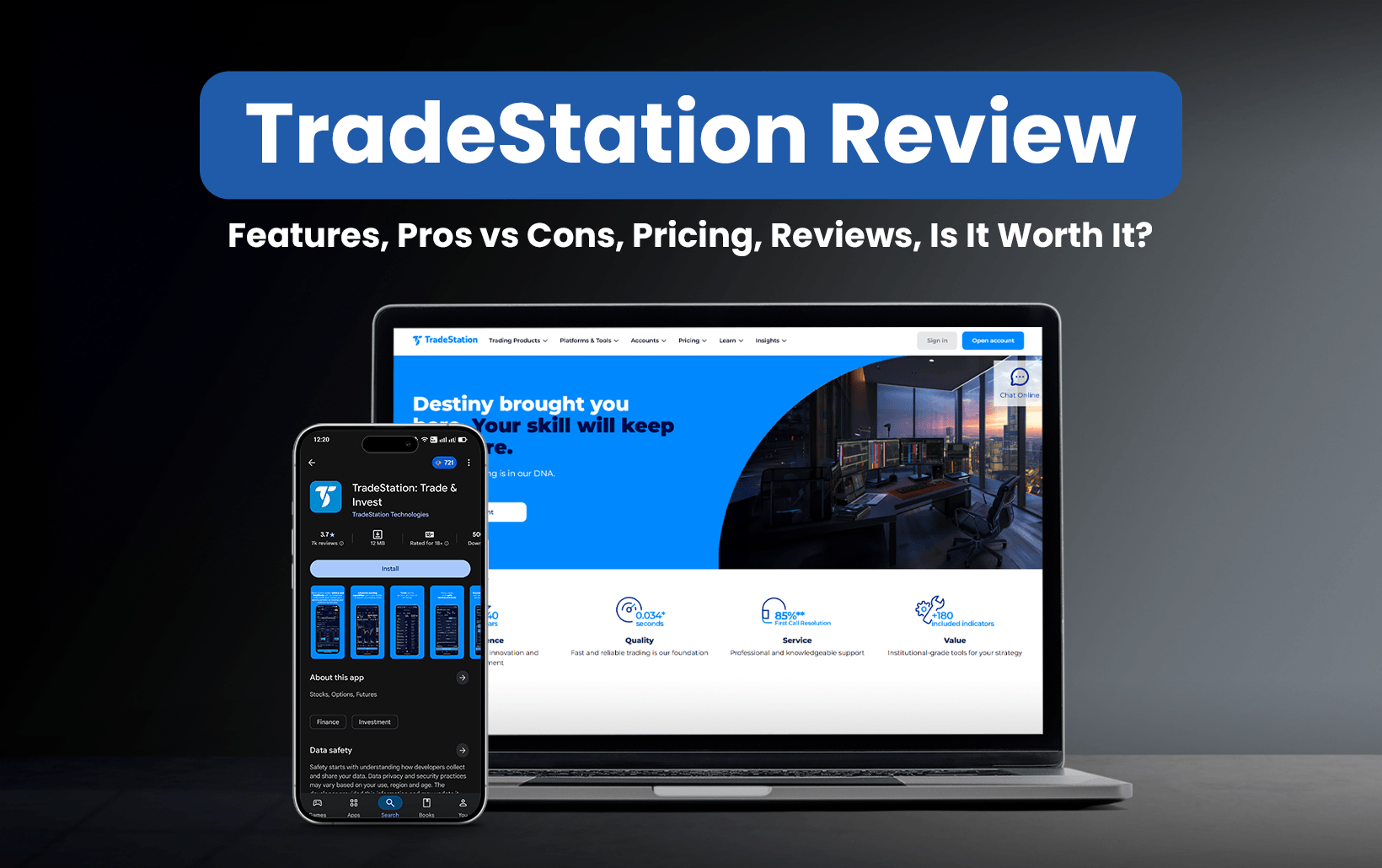
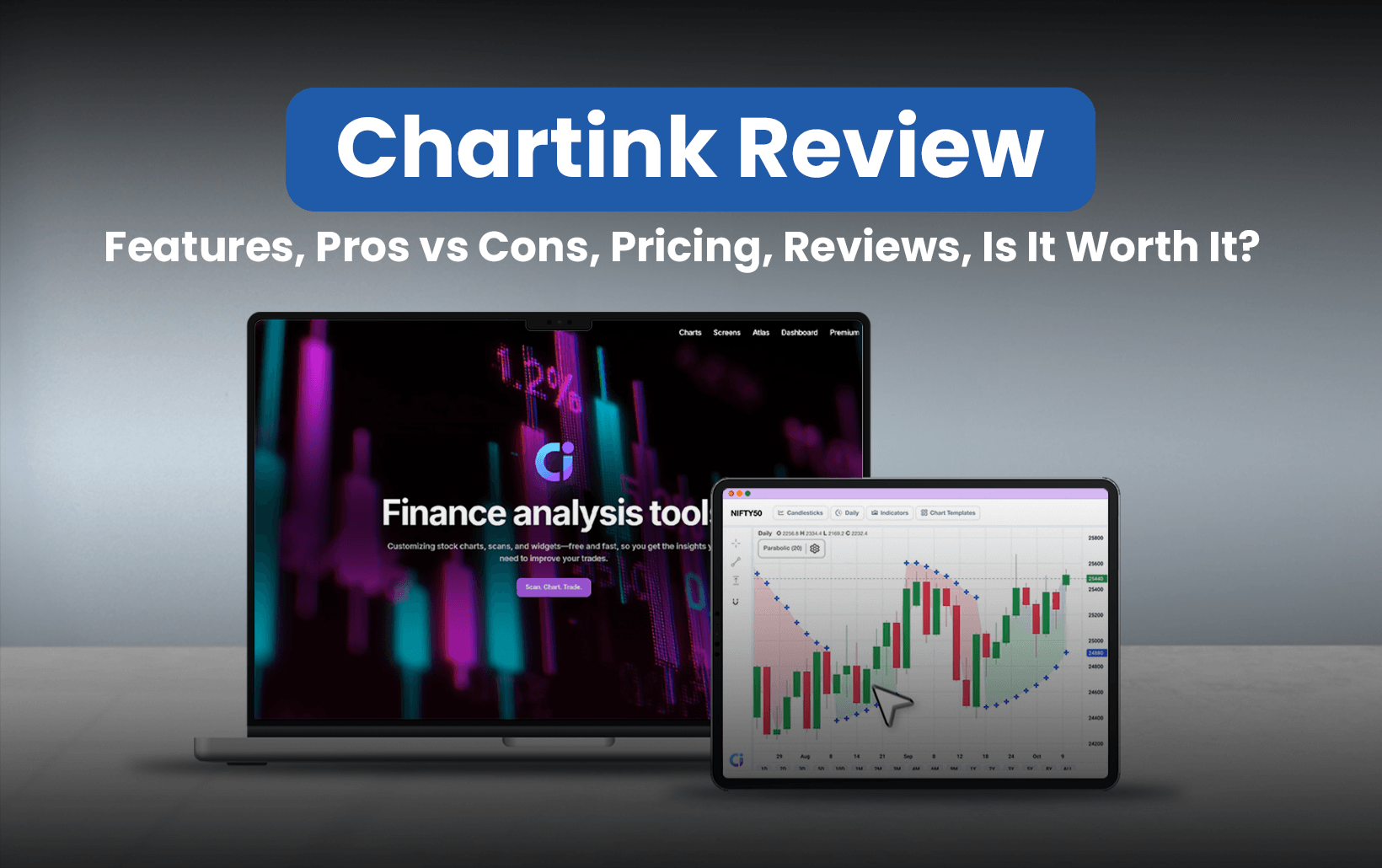
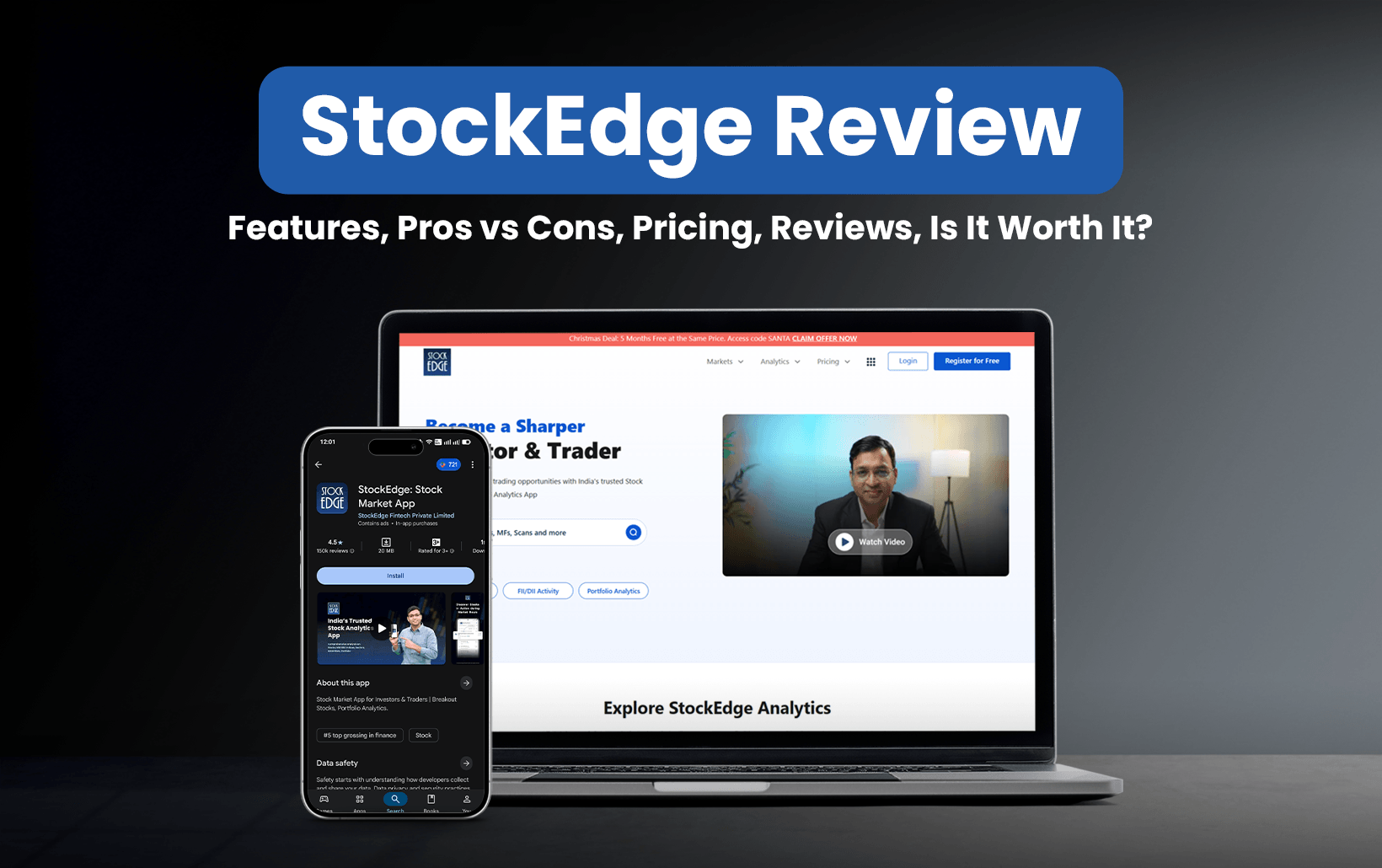
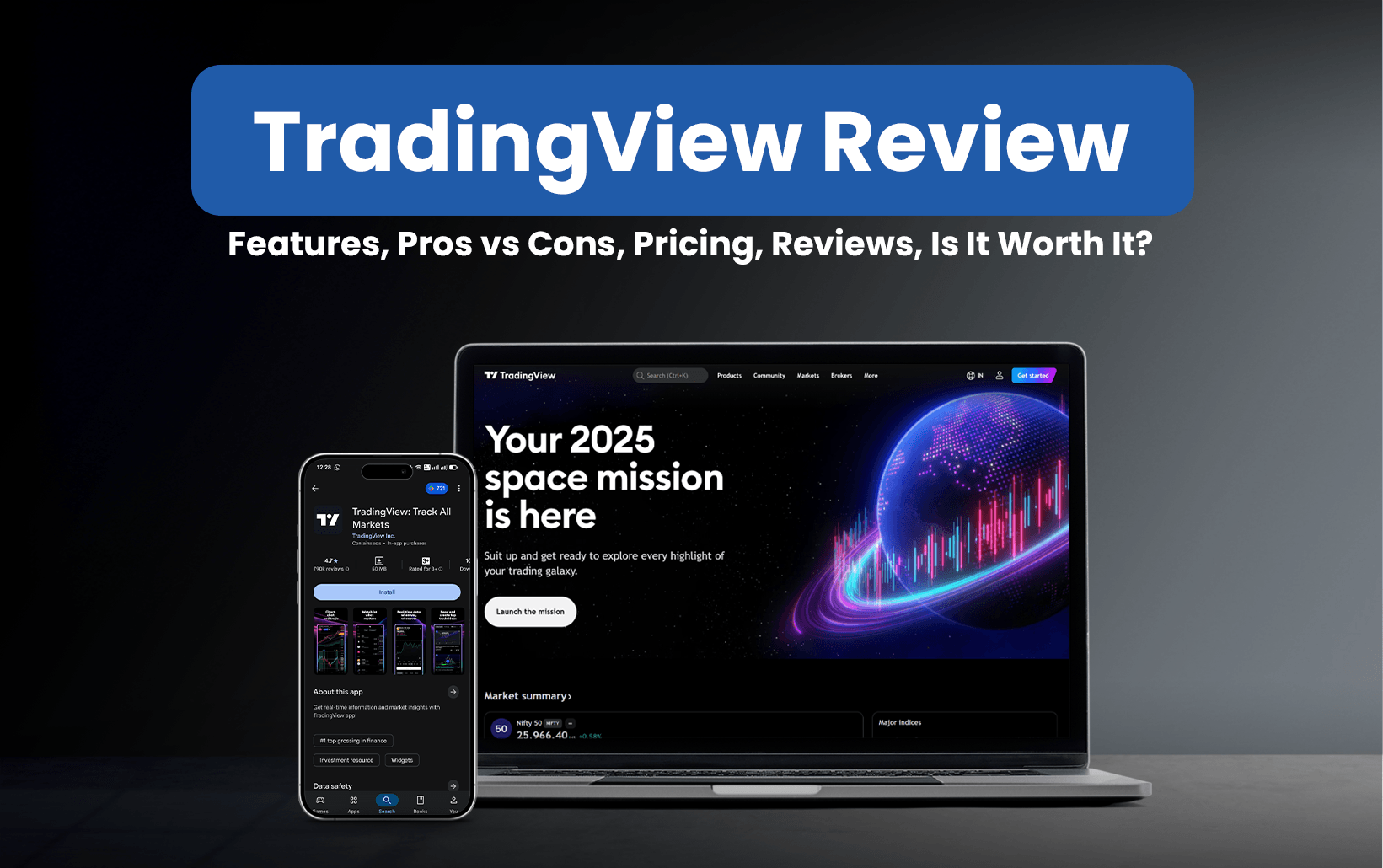

![85 Common Stock Market Terminologies for Dummies [Updated List for 2026] 32 85 Common Stock Market Terminologies for Dummies [Updated List for 2025]](https://www.strike.money/wp-content/uploads/2025/04/Popular-Stock-Market-Terms-for-Beginners-Banner.png)




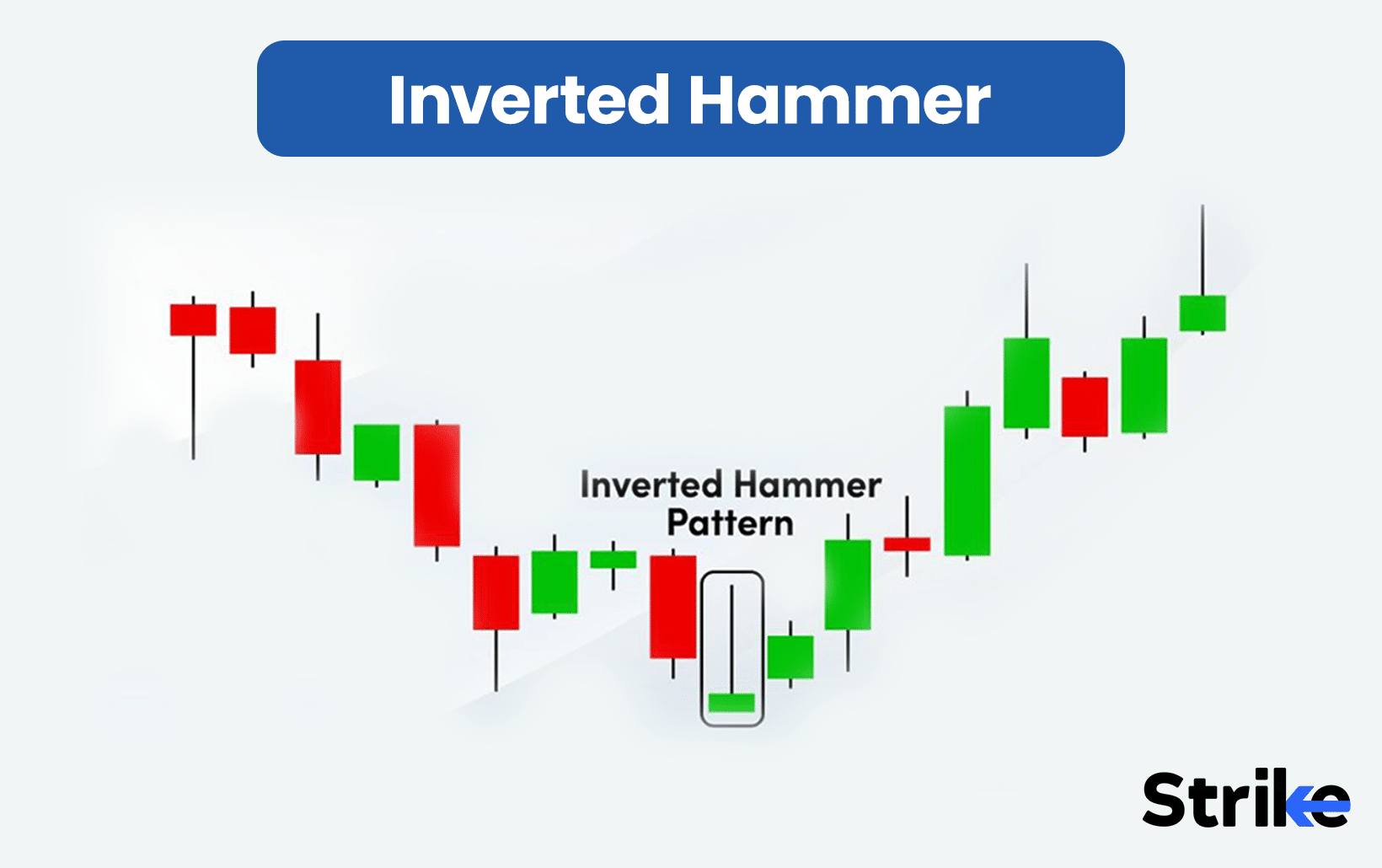
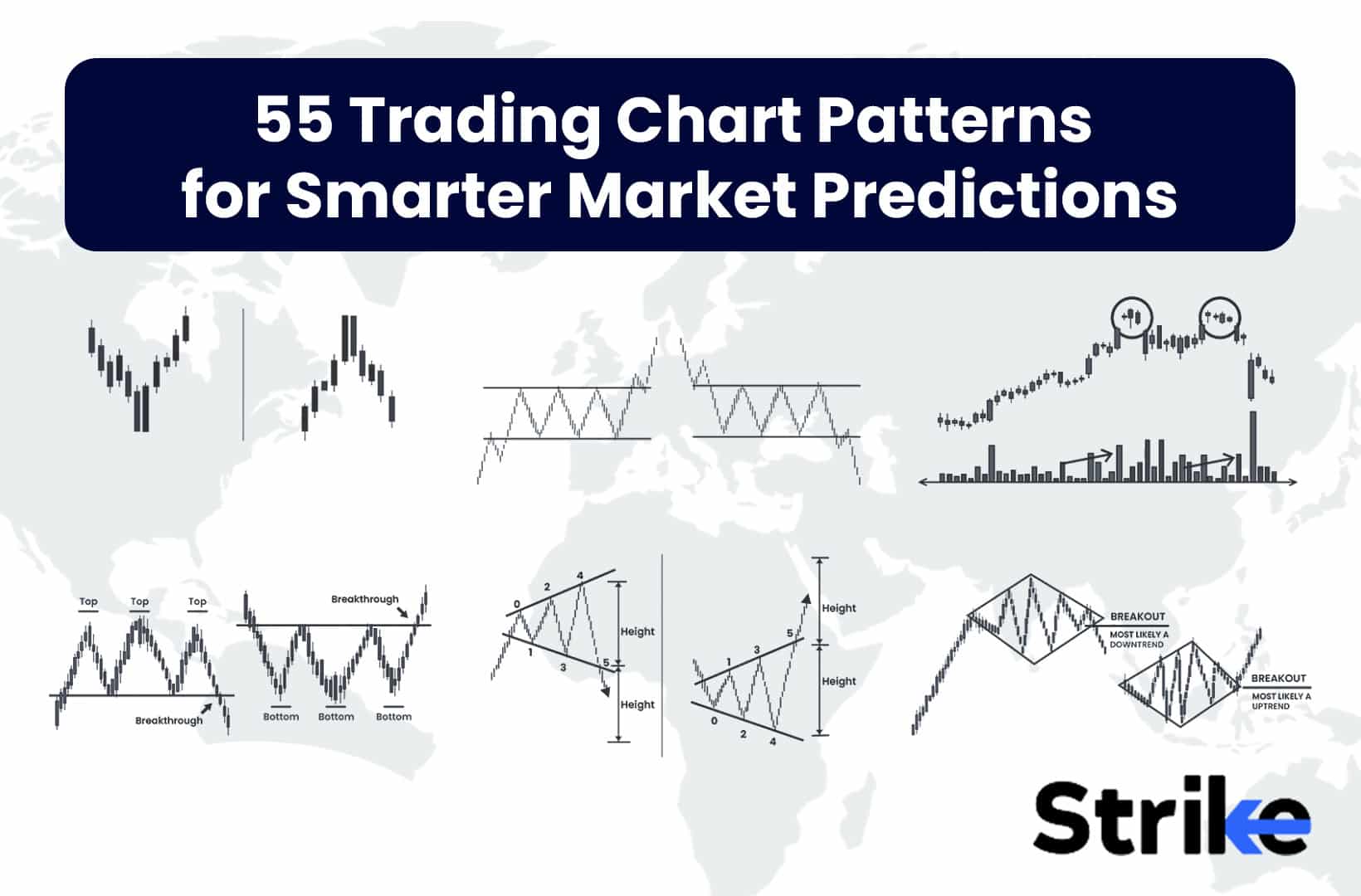




No Comments Yet.